Application of 3D Gel Dosimetry as a Quality Assurance Tool in Functional Leksell Gamma Knife Radiosurgery
Abstract
:1. Introduction
2. Results and Discussion
2.1. Assessment of Dose Gel Application for Quality Control in Gamma Knife Radiosurgery
2.2. Assessment of the Feseability of Dose Gel Application for the Planar Dose Mapping
3. Conclusions
4. Materials, Instruments and Methods
4.1. Dose Gels
4.2. Radiochromic Films
4.3. Irradiation of Radiochromic Films
4.4. Irradiation of Dose Gels
4.5. Evaluation of Dose Gels
Author Contributions
Funding
Institutional Review Board Statement
Informed Consent Statement
Data Availability Statement
Conflicts of Interest
References
- McDonald, D.; Yount, C.; Koch, N.; Ashenafi, M.; Peng, J.; Vanek, K. Calibration of the Gamma Knife Perfexion using TG-21 and the solid water Leksell dosimetry phantom. Med. Phys. 2011, 38, 1685–1693. [Google Scholar] [CrossRef] [PubMed]
- Vienna: INTERNATIONAL ATOMIC ENERGY AGENCY. Dosimetry of Small Static Fields Used in External Beam Radiotherapy, No. 483. 2017. Available online: https://www.iaea.org/publications/11075/dosimetry-of-small-static-fields-used-in-external-beam-radiotherapy (accessed on 10 November 2021).
- Najafi, M.; Shirazi, A.; Geraily, G.; Esfahani, M.; Teimouri, J. Evaluation of dose profiles using Gafchromic EBT3 films in Leksell Gamma Knife 4C around inhomogeneities in the treatment of pituitary adenoma in anthropomorphic heterogeneous head phantom. Radiat. Phys. Chem. 2018, 149, 104–109. [Google Scholar] [CrossRef]
- Lewis, D.; Micke, A.; Yu, X.; Chan, M.F. An efficient protocol for radiochromic film dosimetry combining calibration and measurement in a single scan. Med. Phys. 2012, 39, 6339–6350. [Google Scholar] [CrossRef] [PubMed]
- Vaiano, P.; Consales, M.; Casolaro, P.; Campajola, L.; Fienga, F.; Di Capua, F.; Breglio, G.; Buontempo, S.; Cutolo, A.; Cusano, A. A novel method for EBT3 Gafchromic films read-out at high dose levels. Phys. Med. 2019, 61, 77–84. [Google Scholar] [CrossRef] [PubMed]
- Farajollahi, A.R.; Pak, F.; Horsfield, M.; Myabi, Z. The basic radiation properties of the N-isopropylacrylamide based polymer gel dosimeter. Iran. J. Radiat. Res. 2014, 12, 347–354. [Google Scholar]
- Farhood, B.; Geraily, G.; Abtahi, S.M.M. A systematic review of clinical applications of polymer gel dosimeters in radiotherapy. Appl. Radiat. Isot. 2019, 143, 47–59. [Google Scholar] [CrossRef] [PubMed]
- Watanabe, Y.; Akimitsu, T.; Hirokawa, Y.; Mooij, R.B.; Perera, G.M. Evaluation of dose delivery accuracy of Gamma Knife by polymer gel dosimetry. J. Appl. Clin. Med. Phys. 2005, 6, 133–142. [Google Scholar] [CrossRef] [PubMed] [Green Version]
- Kawamura, H.; Sakae, T.; Terunuma, T.; Ishida, M.; Shibata, Y.; Matsumura, A. Evaluation of three-dimensional polymer gel dosimetry using X-ray CT and R2 MRI. Appl. Radiat. Isot. 2013, 77, 94–102. [Google Scholar] [CrossRef] [PubMed]
- Soliman, Y.S.; El Gohary, M.; Abdelgawad, M.; Amin, E.; Desouky, O. Fricke gel dosimeter as a tool in quality assurance of the radiotherapy treatment plans. Appl. Radiat. Isot. 2017, 120, 126–132. [Google Scholar] [CrossRef] [PubMed]
- Watanabe, Y.; Warmington, L.; Gopishankar, N. Three-dimensional radiation dosimetry using polymer gel and solid radiochromic polymer: From basics to clinical applications. World J. Radiol. 2017, 9, 112. [Google Scholar] [CrossRef] [PubMed]
- Kozicki, M.; Maras, P.; Rybka, K.; Biegartski, T.; Kadłubowski, S.; Petrokokkinos, L. On the development of the VIPAR polymer gel dosimeter for three-dimensional dose measurements. Macromol. Symp. 2007, 254, 345–352. [Google Scholar] [CrossRef]
- Abtahi, S.M.M.; Pourghanbari, M. A new less toxic polymer gel dosimeter: Radiological characteristics and dosimetry properties. Phys. Med. 2018, 53, 137–144. [Google Scholar] [CrossRef] [PubMed]
- Yen, C.-P.; Steiner, L. Gamma Surgery for Functional Disorders, 6th ed.; Elsevier: Amsterdam, The Netherlands, 2012; Volume 1, pp. 1241–1247. [Google Scholar] [CrossRef]
- Witjas, T.; Carron, R.; Boutin, E.; Eusebio, A.; Azulay, J.P.; Régis, J. Essential tremor: Update of therapeutic strategies (medical treatment and gamma knife thalamotomy). Rev. Neurol. 2016, 172, 408–415. [Google Scholar] [CrossRef] [PubMed]
- Mithani, K.; Davison, B.; Meng, Y.; Lipsman, N. The anterior limb of the internal capsule: Anatomy, function, and dysfunction. Behav. Brain Res. 2020, 387, 112588. [Google Scholar] [CrossRef] [PubMed]
- Jaselskė, E.; Adlienė, D.; Rudžianskas, V.; Korobeinikova, E.; Radžiūnas, A. Application of polymer dose gels for millimeter scale target/tumor pre-treatment immitation using gamma knife facility. Nucl. Instrum. Methods Phys. Res. Sect. B Beam Interact. Mater. At. 2020, 470, 56–60. [Google Scholar] [CrossRef]
- Karlsson, A.; Gustavsson, H.; Månsson, S.; McAuley, K.B.; Bäck, S.J. Dose integration characteristics in normoxic polymer gel dosimetry investigated using sequential beam irradiation. Phys. Med. Biol. 2007, 52, 4697–4706. [Google Scholar] [CrossRef] [PubMed]
- Yoon, K.; Kwak, J.; Lee, D.; Cho, B.; Lee, S.; Ahn, S. Development of a 3-dimensional dosimetry system for Leksell Gamma Knife Perfexion. J. Korean Phys. Soc. 2015, 67, 33–37. [Google Scholar] [CrossRef]
- Adlienė, D.; Jaselskė, E.; Rudžianskas, V.; Šeperienė, N. First approach to ionizing radiation based 3D printing: Fabrication of free standing dose gels using high energy gamma photons. Nucl. Instrum. Methods Phys. Res. Sect. B Beam Interact. Mater. At. 2018, 435, 246–250. [Google Scholar] [CrossRef]
- Adliene, D.; Jakstas, K.; Vaiciunaite, N. Application of optical methods for dose evaluation in normoxic polyacrylamide gels irradiated at two different geometries. Nucl. Instrum. Methods Phys. Res. Sect. A Accel. Spectrometers Detect. Assoc. Equip. 2014, 741, 88–94. [Google Scholar] [CrossRef]
- Ashland Inc. Gafchromic TM RTQA2 Film. 2013. Available online: http://www.gafchromic.com/documents/RTQA2_Literature.pdf (accessed on 10 November 2021).

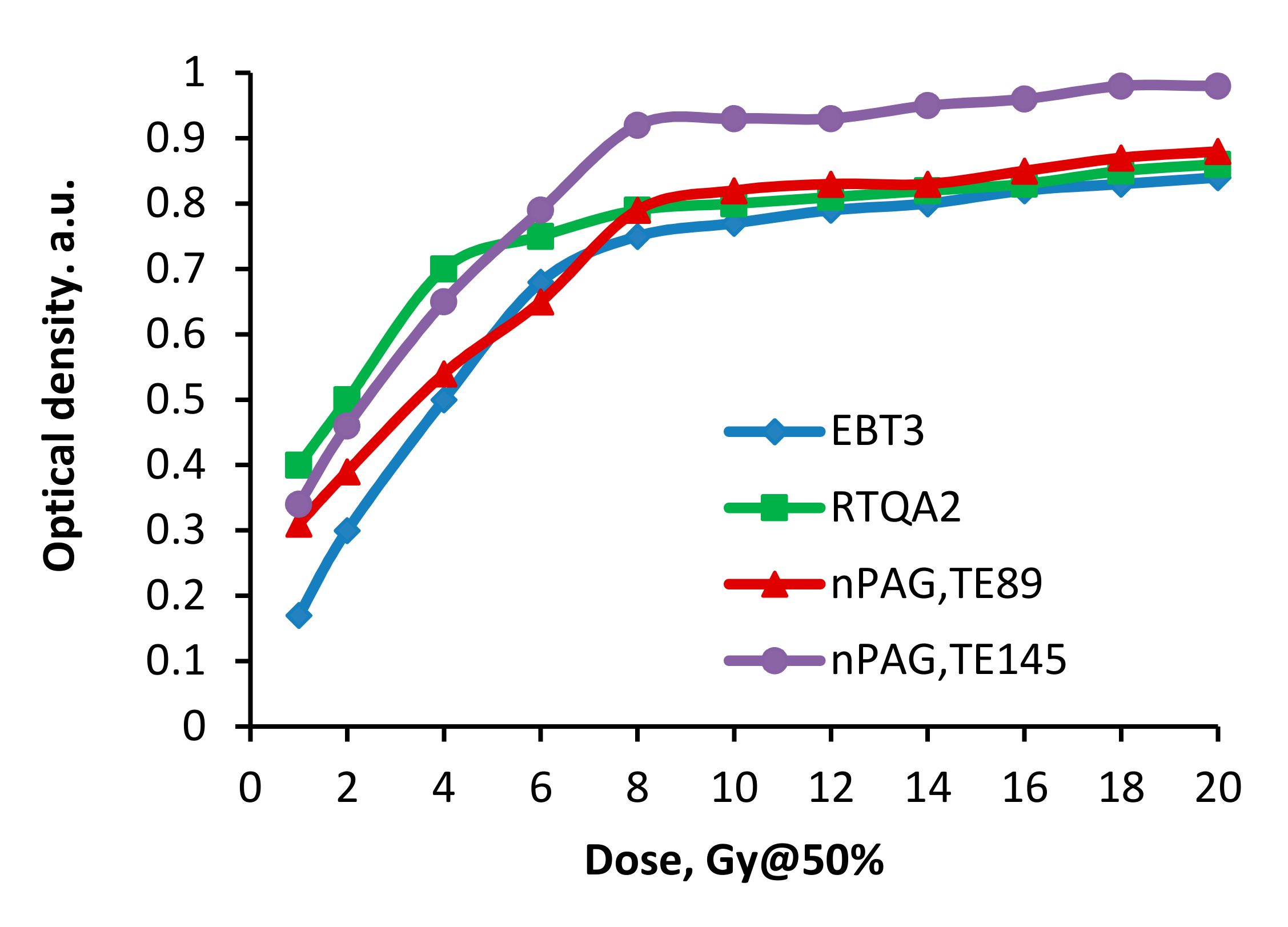

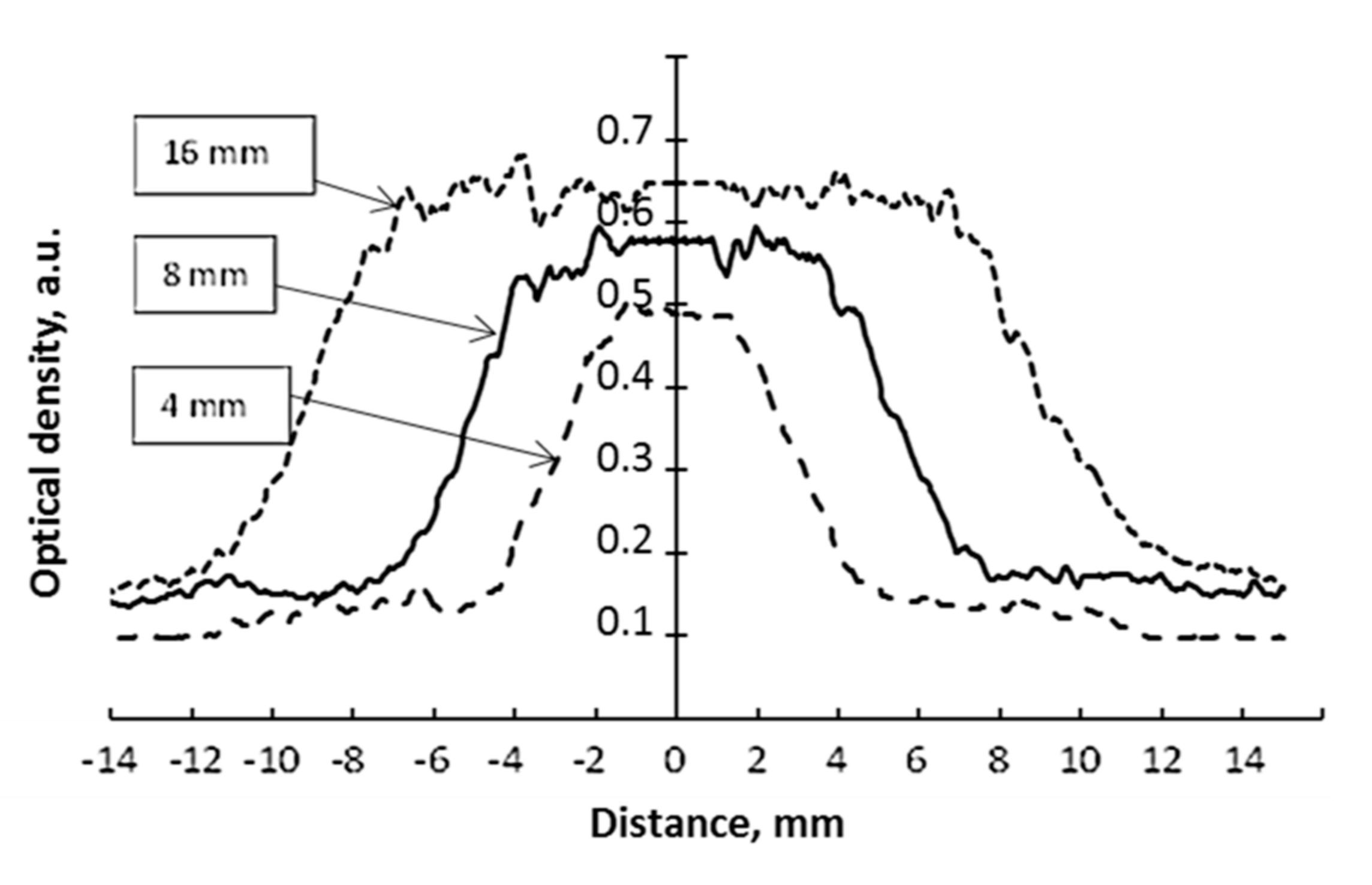
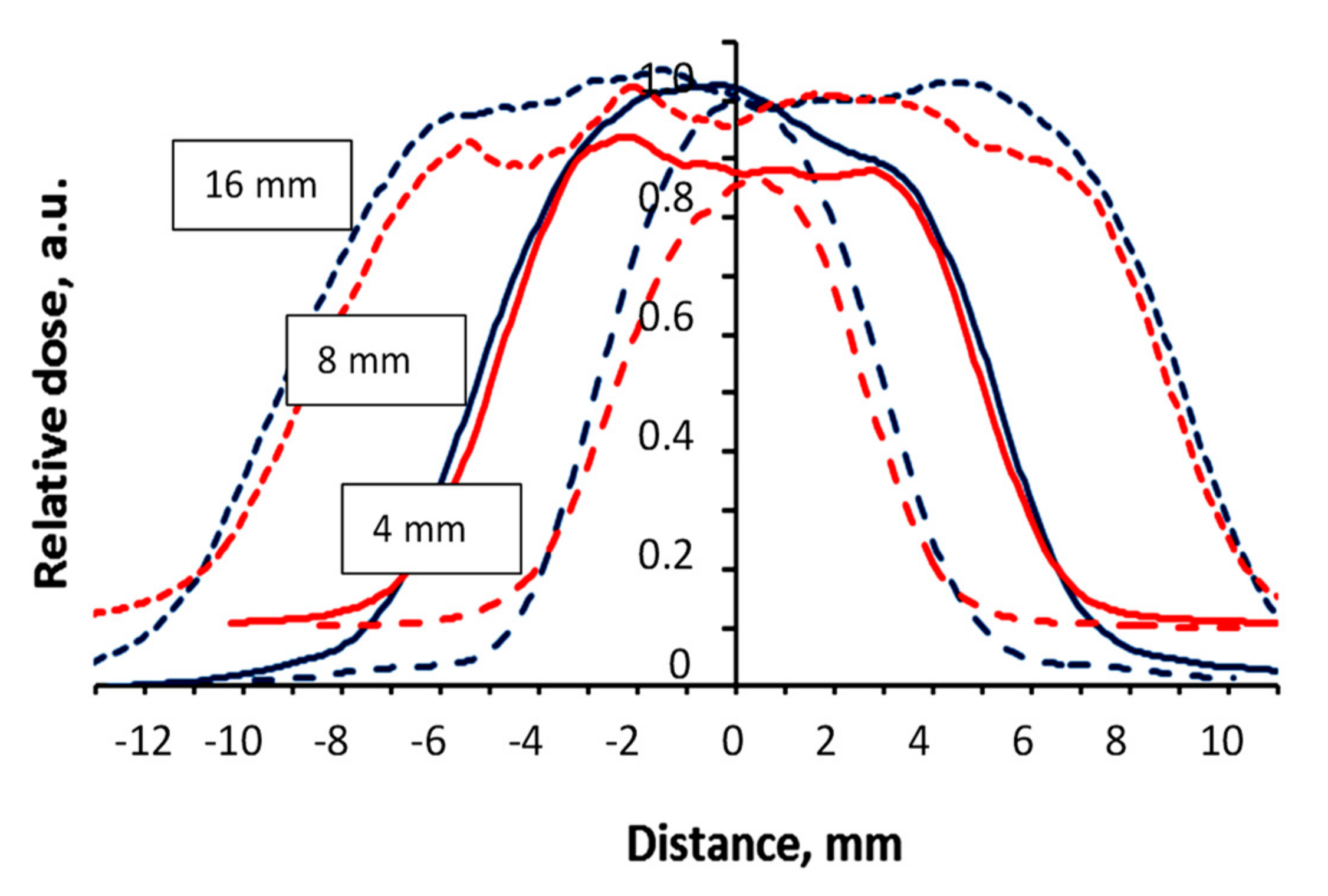
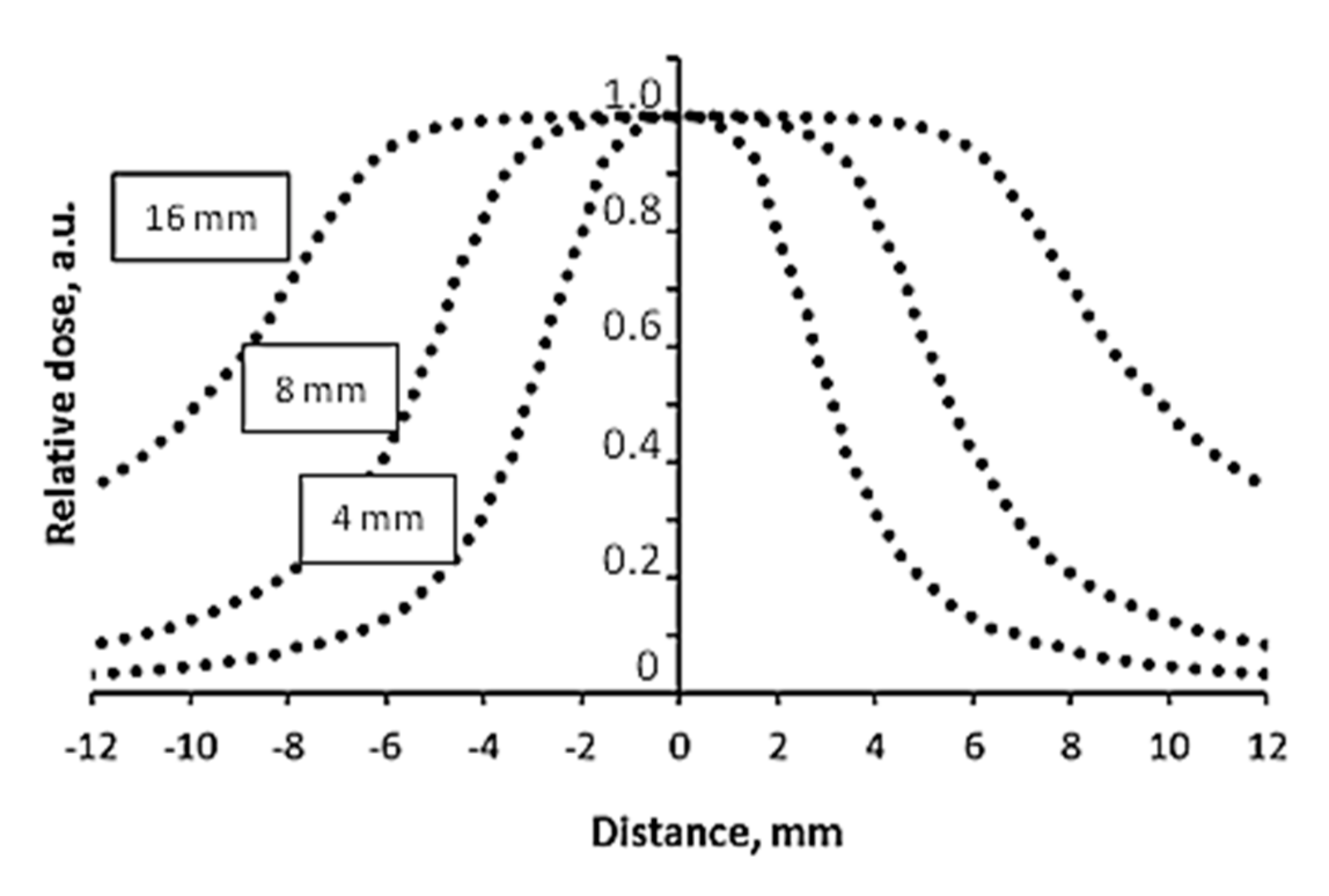






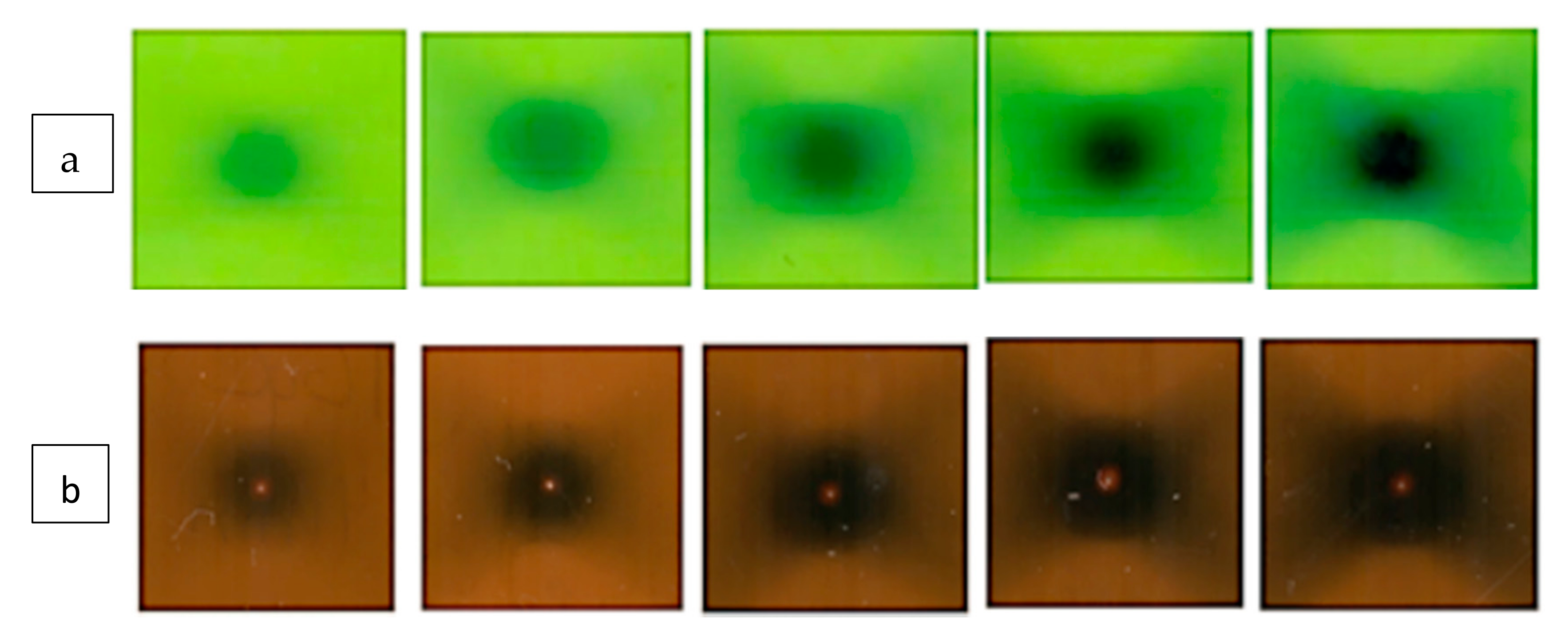
| FWHM, mm (GK Profile, Z Axis) | ||||
|---|---|---|---|---|
| Gammaplan | RTQA2 | EBT3 | Modified nPAG | |
| 4 mm collimator | 6.2 | 5.6 | 5.9 | 6.4 |
| Uncertainty | 9.7% | 4.8% | 3.2% | |
| 8 mm collimator | 11.3 | 10.4 | 10.6 | 11.8 |
| Uncertainty | 7.9% | 6.6% | 4.2% | |
| 16 mm collimator | 19.8 | 17.9 | 18.2 | 19.5 |
| Uncertainty | 10.6% | 8.8% | 1.5% | |
Publisher’s Note: MDPI stays neutral with regard to jurisdictional claims in published maps and institutional affiliations. |
© 2022 by the authors. Licensee MDPI, Basel, Switzerland. This article is an open access article distributed under the terms and conditions of the Creative Commons Attribution (CC BY) license (https://creativecommons.org/licenses/by/4.0/).
Share and Cite
Kudrevicius, L.; Jaselske, E.; Adliene, D.; Rudzianskas, V.; Radziunas, A.; Tamasauskas, A. Application of 3D Gel Dosimetry as a Quality Assurance Tool in Functional Leksell Gamma Knife Radiosurgery. Gels 2022, 8, 69. https://doi.org/10.3390/gels8020069
Kudrevicius L, Jaselske E, Adliene D, Rudzianskas V, Radziunas A, Tamasauskas A. Application of 3D Gel Dosimetry as a Quality Assurance Tool in Functional Leksell Gamma Knife Radiosurgery. Gels. 2022; 8(2):69. https://doi.org/10.3390/gels8020069
Chicago/Turabian StyleKudrevicius, Linas, Evelina Jaselske, Diana Adliene, Viktoras Rudzianskas, Andrius Radziunas, and Arimantas Tamasauskas. 2022. "Application of 3D Gel Dosimetry as a Quality Assurance Tool in Functional Leksell Gamma Knife Radiosurgery" Gels 8, no. 2: 69. https://doi.org/10.3390/gels8020069






